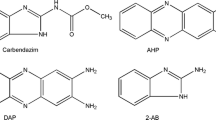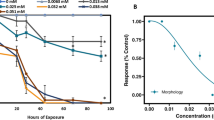Summary
A toxicity test using protozoa as test organisms was devised for pesticides. Two different methods were used, the most probable number method and the absorbance method (based on measurement of protozoa growth through absorbance). The ciliates Colpoda cucullus and Blepharisma undulans and the flagellate Oikomonas termo were isolated from different biological starter cultures and tested with the herbicides Chlorex, MCPA, dichlorprop and Matrigon, the fungicide Benlate, and the insecticide Sumicidin. The protozoans showed quite different sensitivities to the pesticides, using 9-h lethal concentrations (LC50 and LC10) as criteria. The 9-h LC50 (concentration at which 50% of the protozeon population has died after 9 h of incubation) ranged from 0.7 ppm for Benlate to 40000 ppm for Chlorex. The usual soil application rates of Chlorex, MCPA, and Benlate were toxic to some of the organisms.
Similar content being viewed by others
References
Azam F, Fenchel T, Field JG, Meyer-Reil LA, Thingstad F (1983) The ecological role of water-column microbes in the sea. Mar Ecol Prog Ser 10:257–263
Belser LW, Mays EL (1980) Specific inhibition of nitrite oxidation by chlorate and its use in assessing nitrification in soil and sediments. Appl Environ Microbiol 39:505–510
Brink N (1986) Factors affecting mass transport from farmland. In: Saavalainen J, Wakkilainen P (eds) Proc Int Seminar on Land Drainage, Helsinki Univ Technol, Finland, pp 456–473
Clarholm M (1984) Microbes as predators or prey. In: Klug MJ, Reddy CA (eds) Current perspectives on microbial ecology. American Society of Microbiology Washington, pp 321–326
Darbyshire JF, Wheatley RE, Greaves MP, Inkson RHE (1974)A rapid micromethod for estimating bacterial and protozoan population in soil. Rev Ecol Biol 11:465–475
Fenchel T (1983) Protozoa — en systematisk oversigt. Inst Genetik Ökology Kobenhagen, pp 1–23
French JE, Roberts JF (1976) Effect of DDT and polychlorinated biphenyls on cell population growth of Crithidia fasciculata, a flagellated protozoan. Armed Forces Radiobiology Research in Bethesda Report, North Carolina State University
Gelcer JG, Geptner VA (1976) The prostisticide effect of herbicides. Pedobiologia 16:171–184
Greaves MP, Poole NJ, Domsch KH, Jagnow G, Verstraete W (1980) Recommended tests for assessing the side effects of pesticides on the soil micro-flora. Agric Res Council Weed Res Organic Technol Rep No 59
Heuss K (1972) Zur Wirkung einiger Herbizide auf limnische Protisten-Gemeinschaften. Verein Wasser-Boden-Lufthyg 37:222–229
Kemiska bekampningsmedel (1988) För jordbruk, skogsbruk och trädgård. LT:s förlag, Centraltryckeriet AB, Borås
Kreuger J, Brink N (1987) Losses of pesticides from agricultural land. FAO/IAEA Neuherberg November 1987, Vienna, IAEA-SM-197/21
Kudo R (1966) Protozoology. Charles C Thomas, Springfield, Illinois, USA
Legner M (1973) Experimental approach to the role of protozoa in aquatic ecosystem. Am Zool 13:177–192
Lofs-Holmin A (1982) Measuring cocoon production of the earthworm Allolobophora caliginosa (Sav.) as a method of testing sublethal toxicity of pesticides. Swedish J Agric Res 12:117–119
MacRae IC, Vinckx E (1973) Effect of lindane and DDT on populations of protozoa in a garden soil. Soil Biol Biochem 5:245–247
Moore RB (1970) Effects of pesticides growth and survival of Euglena gracilis. Bull Environ Contam Toxicol 12:227–230
Nilsson PE (1951) The action of chlorate on some microbial phenomena in the soil. K Landbrukshögsk Ann 8:60–73
Ogräsnyckeln (1984) Aktuellt från lantbrusksuniversitet 328. Mark-Växter. Sveriges lantbruksuniversitet, Uppsala
Page FC (1967) Taxonomic criteria for limax amoebae with description of 3 new species of Hartmannella and 3 of Vahlkamfia. J Protozool 14:499–521
Personne G, Dive D (1978) Toxicity tests on ciliates: A short review. Ecotoxicol Environ Saf 2:105–114
Pons R, Pussard T (1980) Action des herbicides sur les amibes libres (Rhicopoda, Protozoa). Etude preliminaire. Acta Oecol/Oecol Appl 1:15–20
Prescott LM, Kabovek MK, Tryggestad D (1977) The effects of pesticides, polychlorinated biphenyls and metals on the growth and reproduction of Acanthamoeba castellanii. Bull Environ Contam Toxicol 18:29–33
Rowe R, Todd R, Waide J (1977) Microtechnique for most-probable-number analysis. Appl Environ Microbiol 33:675–680
Sanders HO (1970) Toxicities of some herbicides to six species of freshwater crustaceans. J Water Pollut Control Fed 42:1544–1550
Shivaji S, Saxena DM, Pillai MKK (1978) Mode of action of alkylating agents using a ciliate protozoa as a model system. Arch Protistenkd 120:354–365
Silberstein GB, Hooper AB (1972) Herbicide (24T) effect on Tetrahymena pyriformis. J Protozool 19:28–29
Solyom P (1986) Synpunkter på kvalitetskrav pa vatten till bevattning. Konsulentavdelningens rapporter. Allämnt 84. SLU, Uppsala
Torstensson L, Wessén B (1984) Interactions between the fungicide benomyl and soil microorganisms. Soil Biol Biochem 16:445–452
Train RE (1979) Quality criteria for water. Billing, London
Author information
Authors and Affiliations
Rights and permissions
About this article
Cite this article
Schreiber, B., Brink, N. Pesticide toxicity using protozoans as test organisms. Biol Fert Soils 7, 289–296 (1989). https://doi.org/10.1007/BF00257822
Received:
Issue Date:
DOI: https://doi.org/10.1007/BF00257822




